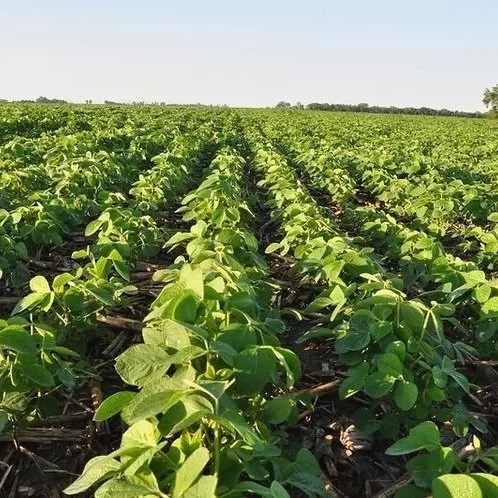Things are looking pretty good overall, we’re done with corn harvest, most of my guys are harvesting rice right now, some of the guys are getting close to the end of rice harvest. Overall, I’d say, we’re in the middle to the other side of rice harvest. Soybean harvest is in full swing, making a lot of progress there. Just starting to defoliate, I guess about ten days into defoliating some cotton.
Read MoreLouisiana leads the country for soybeans dropping leaves. Soybean maturity in the state climbed 10 percentage points to 40% the week ending Aug. 25. That’s just ahead of the five-year average of 37%.
Soybeans in good/excellent condition made up 74% of Louisiana’s crop the week ending Aug. 25. That’s an impressive number on its own, but a nosedive compared to 84% good/excellent soybeans reported the week prior.
Read MoreLouisiana leads the country for soybeans dropping leaves. Soybean maturity in the state climbed 10 percentage points to 40% the week ending Aug. 25. That’s just ahead of the five-year average of 37%.
Read MoreThe Dean Lee Research and Extension Center will play host to the Soybean Production School on September 10th from 4 to 6 PM with activities starting at the Sate Evacuation Shelter near the LSU-A campus.
Read MoreIt’s dry…we went from the end of July when we were trying to look for a break in the rains to now where we’re looking for a rain. We’re trying to finish out the last of these crops, and it’s not going easy.
It depends on where you’re at, on how the crops are looking…the late planted beans are looking really good, but this dry weather, as they move into pod filling stages, is really taking a toll on them. A really good rain would really set this crop up for a good finish.
Read MoreThings are looking pretty good…we’re in the middle of a dry spell right now, which is great for corn harvest, great for wrapping up a cotton crop right now. Soybeans are needing some water, but as long as we’ve got irrigation, we’ll hang in the game a little while. As mentioned, corn harvest is getting into full swing, most everybody’s going to at least get started this week, and there are those who have been started, primarily south of I-20 for the last 10 days or so.
Read MoreThis report contains supply and demand use estimates for the corn, soybean, rice, and cotton markets.
Read MoreThe Crop Production report issued by USDA’s National Agricultural Statistics Service (NASS) forecasted corn production down from 2023 and soybean production up from last year. Corn production is down 1% from last year, forecast at 15.1 billion bushels; soybean growers are expected to increase their production 10% from 2023, forecast at a record high 4.59 billion bushels.
Average corn yield is forecast at record high 183.1 bushels per acre, up 5.8 bushels from last year. NASS also forecasts record high yields in Idaho, Illinois, Indiana, Iowa, Louisiana, Michigan, Nebraska, South Dakota, Washington, and Wisconsin. As of Aug. 4, 67% of this year’s corn crop was reported in good or excellent condition, 10 percentage points above the same time last year.
Read MoreAs the cotton season progresses in Louisiana, there have been several reports of potassium deficiency. Potassium deficiency can weaken the plant, making it easier for plant pathogens to attack. It is very common to see fungal leaf spots on potassium stressed plants. Although pre-mature defoliation due to disease is possible, it is most likely the nutrient deficiency that is the leaf-dropping culprit.
Read MoreUse of a herbicide as a desiccant in soybean has become popular to potentially improve harvest efficiency in Louisiana. Herbicides such as paraquat, Aim, Sharpen, and sodium chlorate are labeled for use in soybean as a desiccant, but paraquat is the most widely used. The paraquat label states at least 65% of pods should be mature (Figure 1) or moisture content should be 30% or less for indeterminate soybean varieties; and at least 50% of the leaves should have dropped and remaining leaves should be yellow for determinate varieties. Table 1 gives the harvest aid application timing label requirements for the labeled products in soybean.
Read MoreAs you are aware, the EPA existing stocks order resulting from the vacated labels of Xtendimax, Engenia, and Tavium herbicides in February of this year ended for soybean on June 30 and July 30 for cotton in Louisiana. Bayer (Xtendimax), BASF (Engenia), and Syngenta (Tavium) have each submitted proposed labels for EPA review and approval this summer 2024.
Read MoreLouisiana agriculture generates approximately $3 billion in sales each year, but in most years agricultural productivity is negatively affected by hurricane damage. Louisianans are familiar with the devastation and loss of life and property that can accompany a hurricane event as the state experiences, on average, one hurricane every three years. The total economic losses from a single hurricane can reach tens of billions of dollars, while agricultural losses can exceed one billion dollars. Louisiana is a major agricultural producer for the United States, but the structures, livestock, and crops are highly exposed to extreme wind and flooding during hurricane events.
Read MoreIn the 11 coastal parishes we consult in, lack of rainfall has not been a problem. Many areas have already exceeded the mean annual rainfall accumulation, and it’s not even August. We have already in some areas received in excess of 65 inches, so we are certainly experiencing the opposite of what we dealt with last year.
Read MorePinnacle Asset Management, L.P., a New York-based alternative asset management firm focused on global commodities markets, today announced that its portfolio company Viserion Grain, LLC, a subsidiary of global agricultural merchant Viserion International Holdco, LLC, has acquired four grain elevator assets from Greenfield Grain, LLC. The assets are located in Parkdale, Arkansas, and Dunn, Crowville, and Lake Providence, Louisiana. Terms of the transaction were not disclosed.
Read MoreMukhtar will lead a team of researchers in the Southeast — a region already disproportionately affected by the changing climate — studying how heat and drought affect soybeans, from the cellular level to the entire plant (known as single cell to field-based phenomics), and the associated microbial communities and soil. He and scientists from the University of Alabama at Birmingham, Mississippi State University and the Louisiana State University Agricultural Center aim to identify natural biological solutions through the microbiome that allow soybeans to survive and thrive despite extreme heat and drought.
Read More














